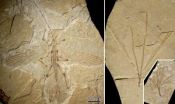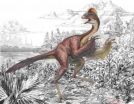(Press-News.org) Rutting stags and clawing bears are but two examples of male animals fighting over a mate, but research in New Phytologist has uncovered the first evidence of similar male struggles leading to the evolution of weaponry in plants.
The team, led by Dr. Andrea Cocucci from the Instituto Multidisciplinario de Biologia Vegetal of Argentina, studied a species of milkweed (Apocynaceae), found in tropical climates. While plants do not mate like animals, but rather reproduce via pollinators such as insects or birds, competition between individuals to exploit those pollinators can result in confrontation between the plants.
Milkweed reproduce by hooking sacs of pollen grains, known as pollinia, to the bodies of birds and other pollinators, which can be unwittingly dropped into another flower to complete pollination.
It is possible for multiple pollinarium to become entangled together due to the limited number of attachment points on the pollinator, and this Dr. Cocucci's team believe, is the source of confrontation.
The team studied the South America milkweed genus Oxypetalum and found horn-like structures on the pollinia sacs which have no obvious biological use. The paper suggests that these horns are used to prevent the sacs from being hooked together with pollinia from other parent plants.
"Our results suggest that neither self-propulsion nor well-developed sensory perception are required for sexual selection to take place through intrasexual struggles," said Dr. Cocucci. "Apparently, only physical contact is enough to influence the mating success of competitors and to promote the evolution of defensive and attack weaponry."
INFORMATION: END
First evidence of plants evolving weaponry to compete in the struggle for selection
2014-03-20
ELSE PRESS RELEASES FROM THIS DATE:
Among US children, more infections caused by drug-resistant bacteria
2014-03-20
Infections caused by a concerning type of antibiotic-resistant bacteria are on the rise in U.S. children, according to a new study published in the Journal of the Pediatric Infectious Diseases Society and available online. Although still uncommon, the bacteria are increasingly found in children of all ages, especially those 1-5 years old, raising concerns about dwindling treatment options.
Researchers led by Latania K. Logan, MD, of Rush University Medical Center in Chicago, analyzed resistance patterns in approximately 370,000 clinical isolates from pediatric patients, ...
Loblolly pine's immense genome conquered
2014-03-20
The massive genome sequence of the loblolly pine — the most commercially important tree species in the United States and the source of most American paper products — has been completed by a nationwide research team, led by a UC Davis scientist.
The draft genome — approximately seven times bigger than the human genome — is the largest genome sequenced to date and the most complete conifer genome sequence ever published. The sequencing was accomplished by using, for the first time, a faster and more efficient analytical process. The achievement is described in two papers ...
Safety first, children
2014-03-20
VIDEO:
A mother and child discuss whether a scenario is dangerous, for a new study by the University of Iowa examining how parents can keep their children safe.
Click here for more information.
As parents, we've all been there: Watching our children teeter on a chair, leap from the sofa, or careen about the playground, fearing the worst. And, we all wonder, how can we teach them to be safer?
Such was the goal of a team of researchers at the University of Iowa, who analyzed in ...
Tiny transistors for extreme environs
2014-03-20
SALT LAKE CITY, March 20, 2014 – University of Utah electrical engineers fabricated the smallest plasma transistors that can withstand high temperatures and ionizing radiation found in a nuclear reactor. Such transistors someday might enable smartphones that take and collect medical X-rays on a battlefield, and devices to measure air quality in real time.
"These plasma-based electronics can be used to control and guide robots to conduct tasks inside the nuclear reactor," says Massood Tabib-Azar, a professor of electrical and computer engineering. "Microplasma transistors ...
Where are we with breast cancer in 2013?
2014-03-20
The global burden of breast cancer remains immense in 2013, with over 1.6 million new cases being diagnosed annually. This burden has been increasing at a rate of 3.1% per year, and while the majority of new cases are diagnosed among women in developed countries, the 450,000 deaths per year from the disease are now equally divided between the developing and developed world, the 9th European Breast Cancer conference (EBCC-9) will hear tomorrow (Friday).
Professor Peter Boyle, Director of the University of Strathclyde Institute of Global Public Health at the International ...
Choice of GP practice pilot most popular with young commuters and patients moving home
2014-03-20
A pilot scheme allowing patients to visit GPs outside the area they live in was most popular among younger commuters and people who had moved house but did not want to change their GP, according to a new report by the London School of Hygiene & Tropical Medicine.
The Department of Health's Choice of GP pilot scheme found that while demand overall was modest, participants were generally positive about the scheme and there was little sign of major increased cost to primary care trusts (PCTs) for providing the service. Patients will be able to register with volunteer practices ...
Future heat waves pose threat to global food supply
2014-03-20
Heat waves could significantly reduce crop yields and threaten global food supply if climate change is not tackled and reversed.
This is according to a new study led by researchers at the University of East Anglia and published today, 20 March, in IOP Publishing's journal Environmental Research Letters, which has, for the first time, estimated the global effects of extreme temperatures and elevated levels of carbon dioxide (CO2) on the production of maize, wheat and soybean.
Earlier studies have found that climate change is projected to reduce maize yields globally ...
Data on antibiotic use in non-EU countries should stimulate development of action plans
2014-03-20
A new study, published in The Lancet Infectious Diseases journal, provides the first ever reliable data on antibiotic use in non-European Union (EU) southern and eastern European countries and newly independent states.
The research, which was led by Dr Herman Goossens, of the Vaccine and Infectious Disease Institute (VAXINFECTIO) at the University of Antwerp, Belgium, is a critical first step in identifying targets for improvements in the way antibiotics are used in these countries. The authors hope that the findings will aid the development of national action plans ...
Fossils of earliest stick insect to mimic plants discovered
2014-03-19
An ancient stick insect species may have mimicked plant leaves for defense, according to a paper published in the open-access journal PLOS ONE on March 19, 2014 by Maomin Wang, from Capital Normal University, China and colleagues.
Many insects have developed defense mechanisms, including the ability to mimic the surrounding environment. Stick and leaf insects mimic plants from their environment, but scientists know little about the original of this interaction due to little or no previous stick insect fossil records showing this adaptation. The scientists discovered three ...
Large feathered dinosaur species discovered in North America
2014-03-19
Fossils found in western North America reveal a new species of large-bodied, feathered oviraptorosaurian theropod dinosaur from the latest Cretaceous Period, according to a paper published in the open-access journal PLOS ONE on March 19, 2014 by Matthew Lamanna from Carnegie Museum of Natural History in Pennsylvania and colleagues.
Known for their beaks, long necks, and relatively short tails, the bird-like oviraptorosaurian group contains dinosaurs with body sizes ranging from a few kilograms to more than one metric ton. The scientists described three well-preserved partial ...





